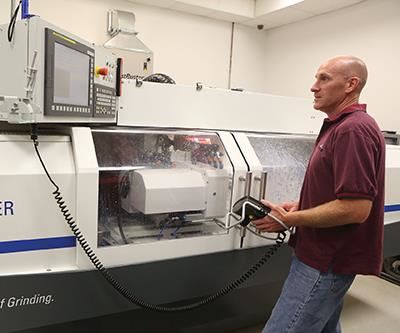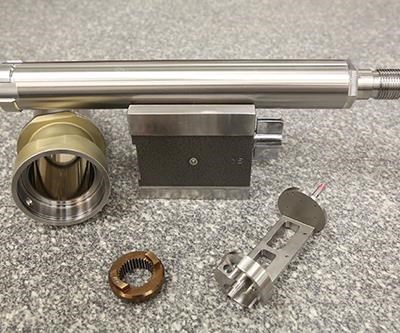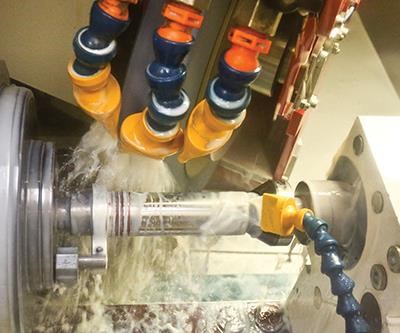Shop Transitions to Aerospace Work with CNC Grinder
J&E Precision Tool met increased demand for complex, high-precision parts with the Studer S33 grinder from United Grinding, leading to improved workflow, part quality, machine utilization and quoting.
“Anybody can make the easy stuff,” says Jon Labrie, general manager of J&E Precision Tool Inc. That reality doesn’t reflect the high-precision work the Southampton, Massachusetts, shop now does, but that wasn’t always the case. The shop began in a one-stall garage, providing general commercial machining services including toolmaking, and production of firearm parts and fixtures. Over the years, the company began taking on higher-precision work, specifically in the aerospace and defense industry sector. As demand increased for even more complex and higher-precision parts, J&E invested in advanced manufacturing systems, including a CNC grinder from United Grinding, and realized a wide range of positive effects on workflow and delivery, part quality, machine utilization, production costs, and quoting.
At any given time, J&E can process 100 jobs simultaneously. It produces microscopic parts—running end mills measuring just under 0.0008 inch in diameter and drilling holes to 0.005 inch in diameter, for example—but, at the same time, it also machines parts as large as 20 by 60 by 18 inches. Job lot sizes range from one to upwards of 2,500 pieces.
All this is done in the company’s current 45,000-square-foot facility, which it moved to in 2001, by its 70 employees. It operates a broad selection of CNC equipment, including three-, four- and five-axis milling machines; 10 lathes; and a seven-axis turn-mill. The company serves customers across the United States in not only the aerospace and defense markets, but also in the microwave equipment industry—a niche market that has been growing like wildfire for the shop, Mr. Labrie says.
However, with new markets and customers came the demand for increasingly complex and higher-precision parts. From its work on aerospace and defense projects, J&E was familiar with machining high-performance materials such as stainless steels, titanium, nickel-based alloys and aluminum, but what really took the shop to the next level, Mr. Labrie says, was grinding those materials.
With customer needs in mind, J&E decided to add advanced CNC grinding capability to its shop floor. Previously, grinding capability was limited to outer diameter, inner diameter and flat grinding, and some lapping on machines that were “old relics,” Mr. Labrie says. Unable to take on production grinding, the company had to subcontract this work. However, issues with cost and scheduling constantly arose.
“We manufacture parts from beginning to end, from raw stock to finished parts. We could no longer depend on someone else to grind parts to the schedule we needed,” he says. “We were at the mercy of our supplier. He did a fantastic job, but had many other customers also vying for his time. This is when we acquired a CNC grinder. It eliminated a lot of those problems.”
After researching available grinding technology, J&E purchased a Studer S33 universal cylindrical grinder from United Grinding (Miamisburg, Ohio) in 2013. Mr. Labrie says United Grinding helped his company get up to speed quickly with the new machine. “They came into our facility and trained us for a week,” he says. “Then, after we ran the machine for a while, they came back for another week once we knew more about
what we were doing and had more questions.”
When grinding exotic materials, choices of wheel types, speeds and feeds, and cutting fluids can make a significant difference in final part dimensions and quality, he explains. The shop occasionally resorts to trial and error to find optimal grinding parameters, but the grinding knowledge and experience of personnel usually produces the best combinations of tooling and parameters. The machine’s operators also program the shop’s grinding processes.
The S33 processes medium-size workpieces both individually and in batches, and it features one ID wheel and two OD wheels. Its wheelhead has two motor spindles for external grinding as well as an internal grinding attachment, which enables the company to grind complex workpieces in a single clamping.
Creating effective grinding setups can be a challenge, Mr. Labrie says, because they occasionally involve “crazy stuff and other unique fixtures” to hold parts that are not round or simple to clamp. “With tight tolerances, you don’t want to squeeze a thin-walled part out of round, push the process too hard, or add stresses during grinding,” he says. “And fixturing is often the determining factor of whether a part is acceptable once grinding is complete.”
The S33 grinder has enhanced the shop’s ability to maintain top part quality, he says. Previously, some parts were both roughed and finished on turning centers. Now, many of those same parts are roughed on a turning center and finished on the grinder. Along with improving part quality, this enables the company to improve production time on these parts. Plus, replacing turning with grinding frees up its turning centers to process other parts, Mr. Labrie says.
Another benefit of the Studer grinder is that J&E has regained full control of its grinding process. It can now take on jobs it would’ve had to turn down in the past. Also, Mr. Labrie can now decide to put two shifts on a part or run it over the weekend to help ensure on-time delivery.
Grinding parts in-house instead of subcontracting the work positively affects the quoting process as well. Mr. Labrie says that quotes previously took into account the subcontractor’s grinding charge, which included that subcontractor’s overhead costs and profit margin. Now, those outside costs are eliminated, and J&E can offer customers more competitive pricing.
Adding flexible CNC grinding technology has affected nearly every aspect of J&E’s production process. Grinding capability and process control have facilitated the addition of new markets and customers, higher part quality, reliable delivery times, and lower costs. Mr. Labrie expects the progress to continue: “We never stop looking forward,” he says.
Related Content
Choosing The Right Grinding Wheel
Understanding grinding wheel fundamentals will help you choose the right wheel for the job.
Read MoreWhen Organic Growth in Your Machine Shop Isn’t Enough
Princeton Tool wanted to expand its portfolio, increase its West Coast presence, and become a stronger overall supplier. To accomplish all three goals at once, acquiring another machine shop became its best option.
Read MoreBuying a Lathe: The Basics
Lathes represent some of the oldest machining technology, but it’s still helpful to remember the basics when considering the purchase of a new turning machine.
Read MoreVolumetric Accuracy Is Key to Machining James Webb Telescope
To meet the extreme tolerance of the telescope’s beryllium mirrors, the manufacturer had to rely on stable horizontal machining centers with a high degree of consistency volumetric accuracy.
Read MoreRead Next
3 Mistakes That Cause CNC Programs to Fail
Despite enhancements to manufacturing technology, there are still issues today that can cause programs to fail. These failures can cause lost time, scrapped parts, damaged machines and even injured operators.
Read MoreThe Cut Scene: The Finer Details of Large-Format Machining
Small details and features can have an outsized impact on large parts, such as Barbco’s collapsible utility drill head.
Read More















.png;maxWidth=300;quality=90)

.png;maxWidth=300;quality=90)











